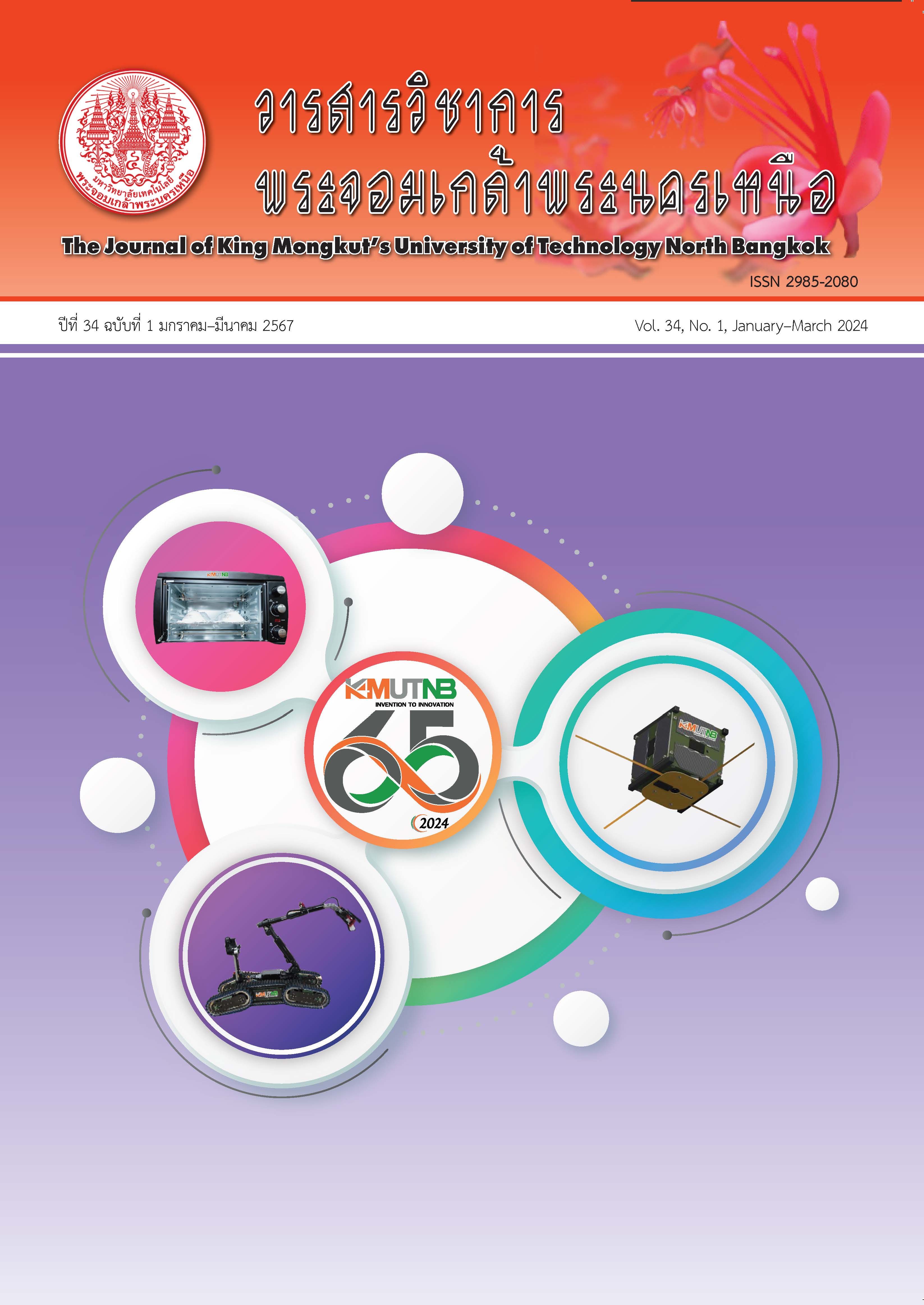การวิเคราะห์แผ่นพื้นหนาออกเซติกแบบออร์โททรอปิกด้วยวิธีบาวน์ดารีเอลิเมนต์
Main Article Content
บทคัดย่อ
บทความนี้เสนอการประยุกต์ใช้วิธีบาวน์ดารีเอลิเมนต์เพื่อวิเคราะห์แผ่นพื้นหนาที่ทำจากวัสดุออกเซติกแบบออร์โททรอปิกโดยใช้สมมติฐานแผ่นพื้นหนาตามทฤษฎีของมินด์ลินซึ่งพิจารณาการเสียรูปเนื่องจากแรงเฉือน โดยวัสดุประเภทออกเซติกเป็นวัสดุที่มีค่าอัตราส่วนปัวซงเป็นลบ ซึ่งเป็นผลเนื่องจากการจัดเรียงโครงสร้างภายในของวัสดุ ลักษณะของแผ่นพื้นที่ใช้ในการวิเคราะห์จะเป็นแผ่นพื้นที่มีที่รองรับแบบต่างๆ หรือมีที่รองรับแบบผสม งานวิจัยนี้ประยุกต์ใช้หลักการสมการแอนะล็อกซึ่งจะสามารถแทนสมการควบคุมดั้งเดิมของปัญหาซึ่งมีความซับซ้อนทางคณิตศาสตร์ด้วยสมการปัวซงสามสมการ ภายใต้การกระทำจากแหล่งกำเนิดสมมติโดยมีเงื่อนไขที่ขอบเขตคงเดิม จากนั้นใช้เทคนิคของวิธีบาวน์ดารีเอลิเมนต์ร่วมกับเรเดียลเบสิสฟังก์ชันทำให้ได้สมการอินทิกรัลที่ขอบเขต ซึ่งจะมีการแบ่งเอลิเมนต์เฉพาะที่ขอบเขตของปัญหาเท่านั้น จากผลการศึกษาแสดงให้เห็นว่าผลการคำนวณจากงานวิจัยนี้มีความถูกต้องที่ดีเยี่ยมเมื่อเทียบกับคำตอบที่ได้จากวิธีเชิงวิเคราะห์ และมีความสอดคล้องกับคำตอบที่ได้จากวิธีไฟไนท์เอลิเมนต์ ผลกระทบของพารามิเตอร์ต่างๆ ต่อการตอบสนองของโครงสร้างแผ่นพื้นได้รับการศึกษาอย่างละเอียด และเพื่อแสดงให้เห็นถึงประสิทธิภาพของวิธีบาวน์ดารีเอลิเมนต์ที่นำเสนอในงานบทความนี้แผ่นพื้นที่มีรูปร่างซับซ้อนแบบต่างๆ ได้ทำการวิเคราะห์และเปรียบเทียบผลการคำนวณที่ได้จากวิธีไฟไนท์เอลิเมนต์
Article Details

อนุญาตภายใต้เงื่อนไข Creative Commons Attribution-NonCommercial-NoDerivatives 4.0 International License.
บทความที่ลงตีพิมพ์เป็นข้อคิดเห็นของผู้เขียนเท่านั้น
ผู้เขียนจะต้องเป็นผู้รับผิดชอบต่อผลทางกฎหมายใดๆ ที่อาจเกิดขึ้นจากบทความนั้น
เอกสารอ้างอิง
R. D. Mindlin, “Influence of rotary inertia and shear on flexural motions of isotropic, elastic plates,” Journal of Applied Mechanics, vol. 18, no. 1, pp. 31–38, 1951.
J. T. Katsikadelis, “The analog equation method: A boundary-only integral equation method for nonlinear static and dynamic problems in general bodies,” Theoretical and Applied Mechanic, vol. 27, pp. 13–38, 2002.
B. N. Pandya and T. Kant, “A refined higherorder generally Orthotropic C0 plate bending element,” Computers & Structures, vol. 28, no. 2, pp. 119–133, 1988.
J. Wang and M. Huang, “Boundary Element Method for Orthotropic thick plates,” Acta Mechanica Sinica, vol. 7, no. 3, pp. 258–266, 1991.
E. Reissner, “The effect of transverse shear deformation on the bending of elastic plates,” ASME Journal of Applied Mechanics, vol. 12, no. 2, pp. 69–77, 1945.
N. G. Babouskos and J. T. Katsikadelis, “Static analysis of thick layered Anisotropic plates with BEM,” in Proceedings 8th GRACM International Congress on Computational Mechanics, Volos, Greece, 2015, pp.12–15.
T. C. Lim, “Shear deformation in thick auxetic plates,” Smart Materials and Structures, vol. 22, no. 8, Article ID 084001, 2013.
H. Chyanbin, Anisotropic Elastic Plates, Springer Science+Business Media, Heidelberg, 2010.
J. T. Katsikadelis, The Boundary Element Method for Plate Analysis, Elsevier, Kidlington, Oxford, 2014.
M. Greenberg, Application of Green’s Functions in Science and Engineering, Prentice Hall, Englewood Cliff, New Jersey, 1971.
J. T. Katsikadelis, The Boundary Elements Theory and Applications, Elsevier, Kidlington, Oxford, 2002.
S. Bergman and M. Schiffer, Kernel Functions and Elliptic Differential Equations in Mathematical Physics, Dover Publications, New York, 2013.
J. T. Katsikadelis, The Boundary Element Method for Engineers and Scientists Theory and Applications, Elsevier, Kidlington, Oxford, 2016.
C. M. Wang, J. N. Reddy, and K. H. Lee, Shear Deformable Beams and Plates: Relationships with Classical Solutions, Elsevier Inc, Kidlington, Oxford, 2000.
T. C. Lim, Auxetic Materials and Structures, Springer Science+Business Media, Singapore, 2015.

